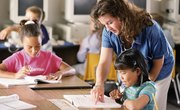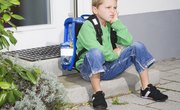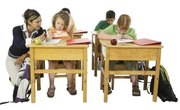EBD (Emotional and Behavioral Disorders) children have special needs that must be addressed within the elementary school classroom. In the past, these children were often separated from the general student population in elementary schools. Now, however, EBD students can learn alongside their general education classmates, with the proper accommodations and modifications in place. The key to an EBD student's success in the elementary classroom is finding the right accommodations and modifications for each student.
What are Emotional and Behavioral Disorders (EBD)?
Emotional and Behavioral Disorders is a classification for children under the special education umbrella. The federal government defines EBD as: • a difficulty to learn that cannot be explained by intellectual, sensory, or health factors; • a difficulty to build or maintain satisfactory interpersonal relationships with peers and teachers; • inappropriate types of behavior (acting out against self or others) or feelings (expresses the need to harm self or others, low self-worth, etc.) under normal circumstances; • a pervasive mood of unhappiness or depression; and • a tendency to develop physical symptoms or fears associated with personal or school problems. A child with these issues may have a difficult time with school relationships, schedules and teacher/student interactions. He or she may be afraid of school, or of trying new things within the classroom.
Modifications and Accommodations
EBD students can learn in the classroom with the right modifications and accommodations that allow a student to be successful during instructional time or test time. For example, a teacher may give a student extended time to finish a test. A student may also receive flexible scheduling for classes or tests in order to finish a test or a project. Students may also receive accommodations with regard to setting/location--changing to a quieter location to finish work, for example. Modifications occur when actual material or content of a class is changed to meet a student's needs. For instance, students may need to do fewer items in math and spelling for homework. A student may need fewer word problems on a math test. Or a student may need to take a different version of the reading test.
Supports for Grades K-2 Classroom
EBD students in grades kindergarten through second grade need a structured classroom with a schedule and a routine that is as close to the same every day as possible. The teachers of young children with EBD should strive to build a positive relationship with the child, and with this in mind, seek to reward positive behavior the child demonstrates. This may take the form of behavior charts or goal sheets, with a daily reward. The child's environment (his desk or cubby or area) should be organized. There should also be a space in the classroom for the child to go to "cool off" or "de-stress," if needed. The child may need help with his or her interpersonal skills, and building friendships.
Supports for Grades 3-5 Classroom
In addition to the supports described in the paragraph above, students in third to fifth grades need additional modifications and accommodations because in many states, students in these grades have standardized high-stakes tests. For these students, some of these accommodations and modifications may be: • cloze passages for subject content; • vocabulary previews; • anticipation guides for content; • individual administration of a test; and • a small group administration for testing. For upper elementary students with EBD, self-monitoring of behavior is easier than in the lower elementary grades. The student may be able to keep his or her own behavior chart and check in with the teacher or the counselor at the end of the day. Rewards could be weekly rather than daily. Again, the positive reinforcement of behavior and the building of positive relationships are encouraged.
Related Articles
References
Resources
Writer Bio
Lori Garrett-Hatfield has a B.J. in Journalism from the University of Missouri. She has a Ph.D. in Adult Education from the University of Georgia. She has been working in the Education field since 1994, and has taught every grade level in the K-12 system, specializing in English education, and English as a Second Language education.











